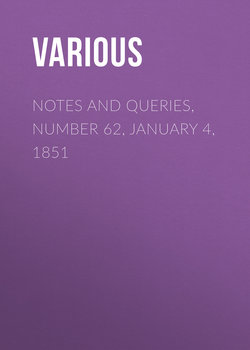Читать книгу Notes and Queries, Number 62, January 4, 1851 - Various - Страница 5
NOTES
MINOR NOTES
ОглавлениеKentish Town in the last Century—
"Thursday night some villains robbed the Kentish Town Stage, and stripped the passengers of their money, watches, and buckles. In the hurry they spared the pockets of Mr. Corbyn, the druggist; but he, content to have neighbour's fare, called out to one of the rogues, 'Stop, friend, you have forgot to take my money'."—Morning Chron. and Land Advertiser, Jan. 9. 1773.
Murray's Hand-book for Devon and Cornwall.—The author does not mention Haccombe Chapel or the Oswell Rocks, both near Newton; the latter is a most picturesque spot, and the view near and far most interesting!—A notice of the tiles, and of the 2ft. 2in effigy at Haccombe, appears in the Arch. Journal, iii. 151. 237.—The monuments are in fine preservation up to the last of the "Haccombes" ante 1342, which is perfect. The chapel would be improved by the removal of the two pews and of the family arms from the velvet cloth on the communion-table!—Tavistock Church has an east window by Williment; pattern, and our Saviour in the centre.—The church by Dartmouth Castle contains a brass and armorial gallery; the visitor should sail round the rock at the harbour entrance, it's appearance from seaward is fine.—Littleham Church has a decorated wooden screen, very elegant.—A work on the Devonshire pulpits and screens would be valuable.
A.C.
Judges Walk, Hampstead.—A friend of mine, residing at Hampstead, has communicated to me the following information, which I forward to you as likely to instruct your readers.
He states that the oldest inhabitant of Hampstead, Mr. Rowbotham, a clock and watchmaker, died recently, at the age of ninety. He told his son and many other persons, that in his youth the Upper Terrace Avenue, on the south-west side of Hampstead Heath was known by the name of "The Judges' Walk," from the circumstance of prisoners having been tried there during the plague of London. He further stated, that he had received this information from his grandmother.
C.R. WELD
Somerset House.
Gray's Alcaic Ode.—A question asked in Vol. i., p. 382, whether "Gray's celebrated Latin Ode is actually to be found entered at the Grande Chartreuse?" is satisfactorily answered in the negative at p. 416. of the same volume, and its disappearance traced to the destructive influence of the first French Revolution.
It may not, however, be without interest to some of your readers to know, that this elegant "Alcaic" was to be found at the Chartreuse not very long before the outbreak of that great political tempest, proof of which will be found in the following extract taken from the 9th volume of Malte-Brun's Annales des Voyages, Paris, 1809. It is found in a paper entitled "Voyage à la Grande Chartreuse en 1789. Par M. T*******," and is in p. 230:
"L'Album, ou le grand livre dans lequel les étrangers inscrivent leurs noms, présente quelquefois une lecture intéressante. Nous en copiâmes quelques pages. Le morceau le plus digne d'être conservé est sans doute l'Ode latine suivante du célèbre poëte anglais Gray. Je ne crois pas qu'elle ait été publiée encore."
Then follows the ode, as usually printed, excepting that in the third line,
"Nativa nam certe fluentia,"
the words "nam certe" are transposed.
G.B.
Fleet Marriages.—The General Evening Post, June 27-29, 1745, contains the following singular Note of a Fleet Marriage:—
"Yesterday came on a cause at Doctors' Commons, wherein the plaintiff brought his action against the defendant for pretending to be his wife. She in her justification pleaded a marriage at the Fleet the 6th of February, 1737, and produced a Fleet certificate, which was not allowed as evidence: she likewise offered to produce the minister she pretended married them, but he being excommunicate for clandestine marriages, could not be received as a witness. The court thereupon pronounced against the marriage, and condemned her in 28l., the costs of the suit."
Y.S.
